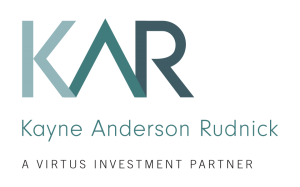
Jon Christensen
Portfolio Manager and Senior Research Analyst
Kayne Anderson Rudnick
KAR portfolio manager Jon Christensen discusses mid-cap equity performance in the fourth quarter, the largest stock contributors and detractors in the KAR Mid Cap Core strategy, and portfolio positioning going into 2024.
Listen Now
Transcript
BEN FALCONE: Hello, this is Ben Falcone, managing director with Kayne Anderson Rudnick, and with me today, I have Jon Christensen, portfolio manager of the KAR Mid Cap Core strategy.
Jon, equities had strong returns for the fourth quarter, characterized by a broadening out of market returns that had previously been confined to a set of mega-cap stocks for the prior nine months of the year. Can you provide our listeners with your perspective on fourth quarter performance for mid-cap equities and how your portfolio performed during the quarter as well as the whole year?
JON CHRISTENSEN: Absolutely. After seeing mid-single digit returns, both positive and negative, in the Russell Midcap® Index in the first three quarters in 2023, Q4 saw a more dramatic run-up in the market with both November and December up over 10% or almost 8%, respectively. Overall, the Index was up almost 13% in the quarter. One of the drivers of the so-called Santa Claus rally was the indication by the Fed that interest rate increases could be behind us, thus, seemingly ushering in eventual rate cuts. Whether that does materialize or not, markets took their typical look forward in mentality and began broadening out returns to include those businesses that were not part of the mega-cap crowd.
In sort of dissecting the quarter, October was almost down 5% for the Russell before it began its ascension the last two months. When looking at the contribution and attribution for the quarter, real estate led the way for the Russell Midcap, increasing almost 17%, followed by consumer discretionary and financials. On the downside, weaker sectors were energy and consumer staples.
In terms of low versus high quality for the Index, it was a mixed bag, with a little more tilt towards low quality. Higher-quality S&P stocks were ahead of lower quality. Low credit ratings were ahead of high. High betas did better than low, and more debt-ridden companies slightly outperformed those with less debt. So, overall in the quarter, low quality won by a low margin.
In terms of performance of the portfolio for the quarter versus this benchmark, Mid Cap Core slightly underperformed due to the low-quality bias and poor stock selection in financials and technology.
As it relates to the full year, the Russell Midcap increased over 17% in 2023 after falling over 17% in 2022. When again looking at the contribution and attribution for the year, the sectors that stood out were technology and industrials. When taking into account the full year for the Russell, low quality was in clear favor—S&P stock rankings, credit ratings, betas, and debt loads were all skewed to low quality for the year.
We were able to overcome this in the KAR Mid Cap Core portfolio through strong stock selection, specifically in healthcare, and an overweight in industrials and an underweight in utilities, thus creating meaningful outperformance versus the benchmark.
BEN FALCONE: Jon, can you discuss a few of the portfolio holdings that were key contributors and detractors to performance within the quarter and for all of 2023?
JON CHRISTENSEN: In terms of contributors from the portfolio in the quarter, they were Monolithic Power Systems, Azenta, Ross Stores, Equifax, and The Cooper Companies.
Let's take a moment for Monolithic. Shares outperformed in the quarter as the company saw strong sequential growth in its enterprise data business given its high market share of power management that are attached to robust sales of NVIDIA’s H100 GPUs, which have been in high demand due to heavy investments in artificial intelligence, or AI. While other markets, such as industrial, communications, and consumer, were notably weaker, the strength in other end markets has provided attractive counterbalance revenue streams in a volatile semiconductor environment.
Discussing the detractors to Mid Cap Core in Q4, they were West Pharmaceutical Services, Zebra Technologies, LPL Financial, Equity LifeStyle Properties, and Old Dominion Freight Line.
Regarding West Pharmaceutical, the company reported solid third quarter revenue—one of the last quarters where year-over-year comparisons would be weaker, thanks to the unusually high COVID demand. That said, investors may have been hoping for even stronger top-line growth given West’s exposure to GLP-1 drug delivery devices. The premium market continues to be strong whereas some of the less advanced drug delivery mechanisms were a bit soft post COVID. We do not see any competitive changes.
BEN FALCONE: Jon, as we head into 2024, thinking about the current backdrop for the economy as well as it being an election year, can you speak about how your portfolio is positioned relative to your benchmark?
JON CHRISTENSEN: We entered 2023 with a general consensus view that the U.S. economy would have a mild recession, and the debate kind of endured all year long. As we move into 2024, the market seems to be absorbing the ups and downs of inflation, the Fed, and recent geopolitical events. The ongoing higher interest rate environment is seemingly favorable for our type of businesses, with lower debt on the balance sheet and solid business models. We also have an election year ahead of us. This does create some uncertainty in terms of entry points for the equity markets. This has been well illustrated in the ups and downs we've been seeing in the market this past year.
So, given these uncertainties and volatility, what does one do? Our goal is to find solid businesses with business models that can react and persevere in reaction to this volatility—high-quality entities that have the ability to pass through pricing while maintaining high customer retention through the value-add of their products to their customers. We also make our investment decisions based on fundamentals and not where the political winds are blowing. But, our mandate is clear and consistent as we focus on high-quality businesses that we believe should outgrow their markets over the long term and take advantage of this market volatility.
BEN FALCONE: Jon, thanks for taking the time to provide your insight to our KayneCast listeners.
This information is being provided by Kayne Anderson Rudnick Investment Management, LLC (“KAR”) for illustrative purposes only. Information contained in this material is not intended by KAR to be interpreted as investment advice, a recommendation or solicitation to purchase securities, or a recommendation for a particular course of action and has not been updated since the date of the material, and KAR does not undertake to update the information presented should it change. This information is based on KAR’s opinions at the time of the recording of this material and are subject to change based on market activity. There is no guarantee that any forecasts made will come to pass. KAR makes no warranty as to the accuracy or reliability of the information contained herein.
Past performance is no guarantee of future results.
3365798
